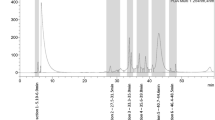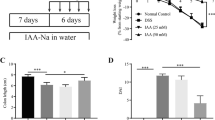Abstract
Purpose
Wasabia japonica (wasabi) has been shown to exhibit properties of detoxification, anti-inflammation and the induction of apoptosis in cancer cells. This study aimed to investigate the molecular mechanism of the cytotoxicity of wasabi extract (WE) in colon cancer cells to evaluate the potential of wasabi as a functional food for chemoprevention.
Methods
Colo 205 cells were treated with different doses of WE, and the cytotoxicity was analyzed by 3-(4,5-dimethylthiazol-2-yl)-2,5-diphenyl tetrazolium bromide. Apoptosis and autophagy were detected by 4′,6-diamidino-2-phenylindole, 5,5′,6,6′-tetrachloro-1,1′,3,3′-tetraethyl-imidacarbo-yanine iodide and staining for acidic vascular organelles (AVOs), along with Western blotting.
Results
The results demonstrated that WE induced the extrinsic pathway and mitochondrial death machinery through the activation of TNF-α, Fas-L, caspases, truncated Bid and cytochrome C. WE also induced autophagy by decreasing the phosphorylation of Akt and mTOR and promoting the expression of microtubule-associated protein 1 light chain 3-II and AVO formation. An in vivo xenograft model verified that tumor growth was delayed by WE treatment.
Conclusion
Our studies revealed that WE exhibits anti-colon cancer properties through the induction of apoptosis and autophagy. These results provide support for the application of WE as a chemopreventive functional food and as a prospective treatment of colon cancer.








Similar content being viewed by others
References
Chang YT, Tseng HC, Huang CC, Chen YP, Chiang HC, Chou FP (2011) Relative down-regulation of apoptosis and autophagy genes in colorectal cancer. Eur J Clin Invest 41:84–92
Li J, Hou N, Faried A, Tsutsumi S, Kuwano H (2010) Inhibition of autophagy augments 5-fluorouracil chemotherapy in human colon cancer in vitro and in vivo model. Eur J Cancer 46:1900–1909
Beretta GD, Pessi MA, Poletti P, Mosconi S, Labianca R (2001) New drugs and combinations in the palliative treatment of colon and rectal cancer. Eur J Surg Oncol 27:595–600
Wang J, Whiteman MW, Lian H, Wang G, Singh A, Huang D, Denmark T (2009) A non-canonical MEK/ERK signaling pathway regulates autophagy via regulating Beclin 1. J Biol Chem 284:21412–21424
Bursch W, Hochegger K, Torok L, Marian B, Ellinger A, Hermann RS (2000) Autophagic and apoptotic types of programmed cell death exhibit different fates of cytoskeletal filaments. J Cell Sci 113:1189–1198
Kelekar A (2005) Autophagy. Ann N Y Acad Sci 1066:259–271
Lin LT, Dawson PWH, Richardson CD (2010) Viral interactions with macroautophagy: a double-edged sword. Virology 402:1–10
Jaeger PA, Wyss-Coray T (2009) All-you-can-eat: autophagy in neurodegeneration and neuroprotection. Mol Neurodegener 4:1–22
Giannopoulou E, Antonacopoulou A, Matsouka P, Kalofonos HP (2009) Autophagy: novel action of panitumumab in colon cancer. Anticancer Res 29:5077–5082
Wang N, Feng Y, Zhu M, Tsang CM, Man K, Tong Y, Tsao SW (2010) Berberine induces autophagic cell death and mitochondrial apoptosis in liver cancer cells: the cellular mechanism. J Cell Biochem 111:1426–1436
Weil MJ, Zhang Y, Nair MG (2005) Tumor cell proliferation and cyclooxygenase inhibitory constituents in horseradish (Armoracia rusticana) and Wasabi (Wasabia japonica). J Agric Food Chem 53:1440–1444
Weil MJ, Zhang Y, Nair MG (2004) Colon cancer proliferating desulfosinigrin in wasabi (Wasabia japonica). Nutr Cancer 48:207–213
Lee YS, Yang JH, Bae MJ, Yoo WK, Ye S, Xue CCL, Li CG (2010) Anti-oxidant and anti-hypercholesterolemic activities of Wasabia japonica. Evid Based Complement Alternat Med 7:459–464
Yano T, Yajima S, Virgona N, Yano Y, Otani S, Kumagai H, Sakurai H, Kishimoto M, Ichikawa T (2000) The effect of 6-methylthiohexyl isothiocyanate isolated from Wasabia japonica (wasabi) on 4-(methylnitrosamino)-1-(3-pyridyl)-1-butanone-induced lung tumorigenesis in mice. Cancer Lett 155:115–120
Tajima H, Kimoto H, Taketo Y, Taketo A (1998) Effects of synthetic hydroxy isothiocyanates on microbial systems. Biosci Biotechnol Biochem 62:491–495
Pedras MSC, Sorensen JL (1998) Phytoalexin accumulation and antifungal compounds from the crucifer wasabi. Phytochem 49:1959–1965
Uto T, Fujii M, Hou DX (2005) 6-(Methylsulfinyl) hexyl isothiocyanate suppresses inducible nitric oxide synthase expression through the inhibition of Janus kinase 2-mediated JNK pathway in lipopolysaccharide-activated murine macrophages. Biochem Pharmacol 70:1211–1221
Watanabe M, Ohata M, Hayakawa S, Isemura M, Kumazawa S, Nakayama T, Furugori M, Kinae N (2003) Identification of 6-methylsulfinylhexyl isothiocyanate as an apoptosis-inducing component in wasabi. Phytochem 62:733–739
Lin HM, Tseng HC, Wang CJ, Chyau CC, Liao KK, Peng PL, Chou FP (2007) Induction of autophagy and apoptosis by the extract of Solanum nigrum Linn in HepG2 cells. J Agric Food Chem 55:3620–3628
Traganos F, Darzynkiewicz Z (1994) Lysosomal proton pump activity: supravital cell staining with acridine orange differentiates leukocyte subpopulations. Methods Cell Biol 41:185–194
Wu CH, Wu CC, Ho YS (2007) Antitumor activity of combination treatment of Lentinus edodes mycelium extracts with 5-fluorouracil against human colon cancer cells xenografted in nude mice. J Cancer Mol 3:15–22
Rose P, Faulkner K, Williamson G (2000) 7-Methylsulfinylheptyl and 8-methylsulfinyloctyl isothiocyanates from watercress are potent inducers of phase II enzymes. Carcinogenesis 21:1983–1988
Zimmermann NS, Gerendas J, Krumbein A (2007) Identification of desulphoglucosinolates in Brassicaceae by LC/MS/MS: comparison of ESI and atmospheric pressure chemical ionisation-MS. Mol Nutr Food Res 51:1537–1546
Pająk B, Kania E, Gajkowska B, Orzechowski A (2012) Verapamil-induced autophagy-like process in colon adenocarcinoma COLO 205 cells; the ultrastructural studies. Pharmacol Rep 64:991–996
Danovi D, Cremona CA, Machado-da-Silva G, Basu S, Noon LA, Parrinello S, Lloyd AC (2010) A genetic screen for anchorage-independent proliferation in mammalian cells identifies a membrane-bound neuregulin. PLoS ONE 5:e11774
Anto RJ, Mukhopadhyay A, Denning K, Aggarwal BB (2002) Curcumin (diferuloylmethane) induces apoptosis through activation of caspase-8, BID cleavage and cytochrome c release: its suppression by ectopic expression of Bcl-2 and Bcl-xl. Carcinogenesis 23:143–150
Liu N, Tai S, Ding B, Thor RK, Bhuta S, Sun Y, Huang J (2012) Arsenic trioxide synergizes with everolimus (Rad001) to induce cytotoxicity of ovarian cancer cells through increased autophagy and apoptosis. Endocr Relat Cancer 19:711–723
Spiers DE, Candas V (1984) Relationship of skin surface area to body mass in the immature rat: a reexamination. J Appl Physiol Respir Environ Exerc Physiol 56:240–243
Stoner GD, Morse MA, Kelloff GJ (1997) Perspectives in cancer chemoprevention. Environ Health Perspect 105:945–954
Blažević I, Radonić A, Skočibušić M, De Nicola GR, Montaut S, Iori R, Rollin P, Mastelić J, Zekić M, Maravić A (2011) Glucosinolate profiling and antimicrobial screening of Aurinia leucadea (Brassicaceae). Chem Biodivers 8:2310–2321
Pajak B, Orzechowski A (2004) Complex forms of immune insufficiency to some cytokines (TNF-alpha, interferons) in colorectal cancers as exemplified by the COLO 205 cell line. Mechanism of resistance with special reference to signaling proteins and cytokines. Postepy Hig Med Dosw 58:428–437
Lin HH, Chen JH, Kuo WH, Wang CJ (2007) Chemopreventive properties of Hibiscus sabdariffa L. on human gastric carcinoma cells through apoptosis induction and JNK/p38 MAPK signaling activation. Chem Biol Interact 165:59–75
Levine B, Kroemer G (2008) Autophagy in the pathogenesis of disease. Cell 132:27–42
Klionsky DJ, Emr SD (2000) Autophagy as a regulated pathway of cellular degradation. Science 290:1717–1721
Høyer-Hansen M, Jäättelä M (2008) Autophagy: an emerging target for cancer therapy. Autophagy 4:574–580
Singletary K, Milner J (2008) Diet, autophagy, and cancer: a review. Cancer Epidemiol Biomarkers Prev 17:1596–1610
Shingu T, Fujiwara K, Bögler O, Akiyama Y, Moritake K, Shinojima N, Tamada Y, Yokoyama T, Kondo S (2008) Inhibition of autophagy at a late stage enhances imatinib-induced cytotoxicity in human malignant glioma cells. Int J Cancer 124:1060–1071
Albert JM, Kim KW, Cao C, Lu B (2006) Targeting the Akt/mammalian target of rapamycin pathway for radiosensitization of breast cancer. Mol Cancer Ther 5:1183–1189
O’Reilly T, McSheehy PM, Wartmann M, Lassota P, Brandt R, Lane HA (2011) Evaluation of the mTOR inhibitor, everolimus, in combination with cytotoxic antitumor agents using human tumor models in vitro and in vivo. Anticancer Drugs 22:58–78
Tai S, Sun Y, Liu N, Ding B, Hsia E, Bhuta S, Thor RK, Damoiseaux R, Liang C, Huang J (2012) Combination of Rad001 (Everolimus) and Propachlor synergistically induces apoptosis through enhanced autophagy in prostate cancer cells. Mol Cancer Ther 11:1320–1331
White E, DiPaola RS (2009) The double-edged sword of autophagy modulation in cancer. Clin Cancer Res 15:5308–5316
Maiuri MC, Zalckvar E, Kimchi A, Kroemer G (2007) Self-eating and self-killing: crosstalk between autophagy and apoptosis. Nat Rev Mol Cell Biol 8:741–752
Mariño G, Niso-Santano M, Baehrecke EH, Kroemer G (2014) Self-consumption: the interplay of autophagy and apoptosis. Nat Rev Mol Cell Biol 15:81–94
Acknowledgments
This study was supported by the Grants from the National Science Council of Taiwan (NSC 99-2632-B-040-001-MY3 and NSC100-2313-B-040-002-MY3).
Conflict of interest
The authors have declared no conflict of interest.
Author information
Authors and Affiliations
Corresponding authors
Rights and permissions
About this article
Cite this article
Hsuan, SW., Chyau, CC., Hung, HY. et al. The induction of apoptosis and autophagy by Wasabia japonica extract in colon cancer. Eur J Nutr 55, 491–503 (2016). https://doi.org/10.1007/s00394-015-0866-5
Received:
Accepted:
Published:
Issue Date:
DOI: https://doi.org/10.1007/s00394-015-0866-5




